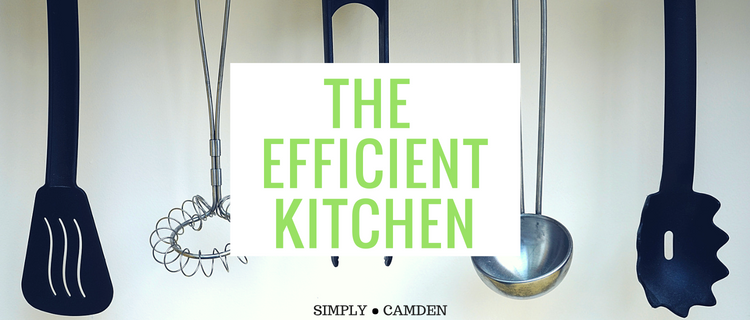
They say the kitchen is the heart of the home. That a lot of our life's hours are spent there. I don't know about you, but for me, this is crazy accurate. Between cooking meals, cleaning up after meals, making a grocery list, unpacking groceries, loading and unloading the dishwasher, making snacks, entertaining...(you get the idea), my Camden apartment's kitchen gets some major foot traffic. So, if we're spending so much of our time in the kitchen, shouldn't we make sure that it's a place where getting from A to Z is as easy as 1,2,3? Where the food we buy gets used before it goes bad? Yes. Yes, it should. An efficient kitchen should be highly functional, logical, and orderly. A place you could navigate blindfolded. Here are four ways to be on the fast-track to a kitchen that not only makes sense but one that also stays in order and isn't a money pit.
1. How to Stock and Organize a Pantry
Ah, yes, the pantry. Where potatoes grow legs they could use to walk away (true story - it happened to me), chips go stale, boxes of cereal get left open and things you swore you'd get to before they expire...expire. It's ok. It happens to the best of us. Here are some awesome tips to make sure this part of your kitchen is as efficient as it can be:
Photo courtesy of Food Storage and Organizing
Keep items that are in bags or boxes and tend to not close well in clear containers with lids, glass jars, or bins. Think along the lines of cereal, dry pasta, baking items such as flour and sugar, cookies, crackers, and nuts. This will keep them fresh longer and in turn, save you money. (Chip Tip: If you don't have clips, here is an awesome video on how to properly close up a chip bag sans any clip of any kind. It's origami magic.)
Do not overcrowd your pantry. Space items out to see them better.
Things that expire quicker should be at the front and at eye level, not buried deep in the back.
Like items should be stored together. Snacks with snacks, drinks with drinks, baking items with baking items and so forth and so on.
Unbox any bulk individual items such as individual snack bags and store them in a bin or basket.
Label bins and containers for easy grabbing and restocking.
Put product labels face-forward so that you know what it is at first glance.
Sort items into categories that fit your lifestyle - An easy sort for most are breakfast, snacks, lunch, dinners, and treats. Or maybe if you work out a lot, then your categories could be sports drinks, energy bars, and protein shakes.

photo credit: pixabay.com
2. How to Stock and Organize a Fridge/Freezer
Just like with a pantry, food can go bad in the refrigerator just because we simply forgot about it. Things can get pushed to the back and left to become something unrecognizable. Don't let that zucchini get mushy or that yogurt go rancid. Here are the best ways to store and organize your cold foods.
Photo courtesy of Food Storage and Organizing
Store veggies and fruits in the humidity-controlled crisper bins. Veggies need a little bit of humidity and fruit does not need much at all.
Things that expire quicker should be at the front.
Face labels forward-facing for easy identification.
Do not over pack your fridge or freezer. The cold air needs to circulate.
Label bins and containers for easy grabbing and restocking.
Refrigerators are colder in some spots than others and certain refrigerated items need to be more chilled. For instance - milk should never go in the door. Did you know that? Here is a placement guide to help you out.
Unbox items and put them into your labeled bins.

Tips for Food Storage and Organizing
Invest in some good containers. Figure out what kind of organizing system you want then purchase the containers. No need to spend money on what you won't or don't need.
Use just about everything before you go shopping again.
Make a meal plan so you're only buying what you need and plan to use - plan being the operative word. This helps with over-buying which in turn helps with over-spending and over-chucking.
Go through your refrigerator weekly. Many things will expire right under your nose. This will help avoid the dreaded "what iiiiiiis this?!" face.
Once a month do a sweep of your pantry to see what you can toss.
Deep clean your pantry seasonally. Shelf by shelf, item by item. This will help you keep up with what you need to replace. And more importantly, what you may not need to spend money on again. I"m talking to you canned salmon.
3. How to Load a Dishwasher
I don't know what it is about a dishwasher, but I have a very love/hate relationship with mine. I love that it washes my dishes for me but I hate that I have to unload it. It is one of two household chores that I despise. Here is a great way to make sure this task is as easy as it can get.
Pre-rinse food off of your dishes but do not rinse it all off. The soap needs something to cling to.
The top rack is best used for glasses, cups, and bowls.
The bottom rack is best used for plates, casserole dishes, and pans.
Anything plastic should be on the top rack to avoid being next to the heating element and prevent possible melting.
Place glasses at an angle so water does not pool on the top and bowls at a slight angle so they get fully rinsed out.
Arrange all plates the same way.
Do not crowd items, i.e. stack them on top of one another.
Knives should point downward and forks and spoons upward.
Make sure to run when it is full.
Always use some sort of rinse-aid such as Jet-Dry.
Following these tips will help your dishwasher run as efficient as possible and prevent you from having to clean your dishes a second time. Also, don't forget to clean out the filter every month. Read this short how-to from a fellow blogger in her blog titled How to Save Money & Time on Cleaning Your Kitchen.

photo credit: camdenliving.com
4. How to Organize Your Kitchen
Kitchens should logically flow. Meaning what's in the drawers by the stove should make sense to have a home by the stove. Coffee mugs should be an arms reach from the coffee pot. You know, that kind of logic. You don't want to have to go across the kitchen each time you need something. There are several super easy change-ups to help make your kitchen more user-friendly without having to call in the pros.
Cleaning supplies should be kept under the sink. Keep them in bins and clearly label them by category.
Clearly define your prep area. Typically this is best by your refrigerator and/or stove. The upper cabinets of this area are where you will put items such as plates and bowls.
Silverware is best placed in the drawer under your plates and bowls cabinet(s).
Glassware such as everyday drinking glasses and stadium type cups are best nearest to your refrigerator or even your sink.
Wine glasses, shot glasses, and other bar items can be in an upper cabinet next to your glassware or a cabinet closest to the outside of your kitchen.
Cooking utensils, if not kept in a utensil jar on the counter, are best placed in a drawer next to your stove.
Pots and pans can be stacked in a bottom cabinet by the stove. The same goes for baking trays. These stand up and can slide right in on the side. Some kitchens even have a narrow cabinet specifically for these.
On the other side of the stove in the bottom cabinet area, place baking dishes and serving pieces.
Small appliances like crock pots, blenders, and food processors can be stored in lower cabinets next to the fridge. Utilizing both the back upper shelf and the lower. If you are lucky enough to have a butler's style pantry, definitely use a lower shelf for these.
Tupperware can take over a cabinet. Make sure you have the matching lids to all of your containers. Place the lids in a something like a magazine file holder (clever, eh?) and then stack your Tupperware according to size.
Junk drawers are OK! Use some sort of system to keep it organized, however. This way you have a handle on it and it doesn't become a catch-all of random things.
Ultimately you will know where the placement of items will work if you take a step back and think about where you perform certain kitchen tasks. As mentioned above, think about your prep area and what you need to grab while there. Think about where you make your coffee in the morning and what all needs to be in those cabinets and drawers. Go through a day in your kitchen, map it out and bam! You've got it figured out.
By doing one or all of these, you are well on your way to a more efficient kitchen. Camden has apartment communities all over the country that boast fantastic kitchens, so by the time you rent one, you'll already know just what to do.
Let's be longtime friends—subscribe today!




